L.I. How Did We Get Here? Local Government

Local Government
A Timeline of Local Government on Long Island
Long Island towns have deep roots, existing well before American independence and even before the creation of New York as a British colony. Towns were an expression of bottom-up self-governance by settlers, whereas counties were later imposed top-down to advance control by the colonial governor, and still administer many state functions locally. Meanwhile, villages were established where concentrations of people within towns wanted to take even more local control from towns that were seen as too big or unresponsive to their needs. The history of Long Island governance is a story of constant tension between central authority versus local control, versus even more local control. Today, across Long Island, there is local control over land use and zoning and local governments continue to provide everyday services such as maintaining roads, sanitation pick up, youth and senior services, community parks, etc. However, the different layers of local government can be a source of confusion. The political culture of Long Island holds deeply to the philosophy that local governments can best provide most municipal services. To know how Long Island functions, it is important to first understand the origins of Long Island’s system of overlapping local governments.
For those who seek to bring communities together to constructively address today’s important quality of life issues, it’s simply foundational to start by first gaining an understanding of Long Island's idiosyncratic local governance structure and the culture that sustains it. To better understand the system we have today, it can be instructive to first consider our shared history and ask the question, Long Island: How Did We Get Here?
This 13-minute video provides highlights from the timeline of the history of local government on Long Island, giving insight into how Long Island and New York State came to have an unusual multi-layered system. It also discusses the pros and cons of funding our local governments and districts through property taxes.
LOCAL GOVERNMENT ON LONG ISLAND — TIMELINE OF EVENTS
1639 — Lion Gardener settles on Gardiner’s Island
With claims for Long Island being made by the Dutch Colony of New Netherlands and settlers in New Haven, Connecticut, Lion Gardiner established the first English colonial settlement in New York State on Gardiner’s Island. Rights to the island were granted to Gardiner by King Charles the First. Gardiner met with Wyandanch, the Chief of the Montauketts, and paid for the land. Gardiner's Island has been held as private property by the descendants of Lion Gardiner since that time, and is the only real estate in the U.S. that is intact from its original royal grant from the British Crown.

Photo credit: Doc Searls CC BY-SA 2.0
1640 — Southold and Southampton settled by English
Puritans from the New Haven and Connecticut colonies settled on the North Fork of Long Island, purchasing land from the Corechaug Indians. These colonies lacked a royal charter and were instead self-governed under “Fundamental Orders.” The Fundamental Orders of Connecticut are considered to be the first written constitution in the Western tradition. A small group arrived the same year from Lynn, Massachusetts, and settled on the South Fork on land obtained from the Shinnecock Nation. The Dutch and English still had competing claims to Long Island and attempts by English to settle in what is now Port Washington were stopped by the Dutch.
1644 — Hempstead settled by English from Connecticut, under a patent from the Dutch
In 1643, John Carman and Robert Fordham purchased land from the local Native Americans. In 1644, English families from Connecticut and Southampton settled at the location of the current Village of Hempstead. They were granted a patent by the Governor of New Netherland for land that is today the towns of Hempstead and North Hempstead. Dutch documents refer to the settlement as Heemstede. This was the first European settlement in what is now Nassau County.
1664 —The English take New Amsterdam from the Dutch
The Dutch colony of New Amsterdam was brought under English rule. The land that would become the states of New York, New Jersey, Vermont, and Delaware, as well as southeast Pennsylvania was granted by King Charles the Second to his brother James, the Duke of York, as the Province of New York. Long Island was included in the "Shire of York,” also called Yorkshire, along with Manhattan, Staten Island, the Bronx, and Westchester.
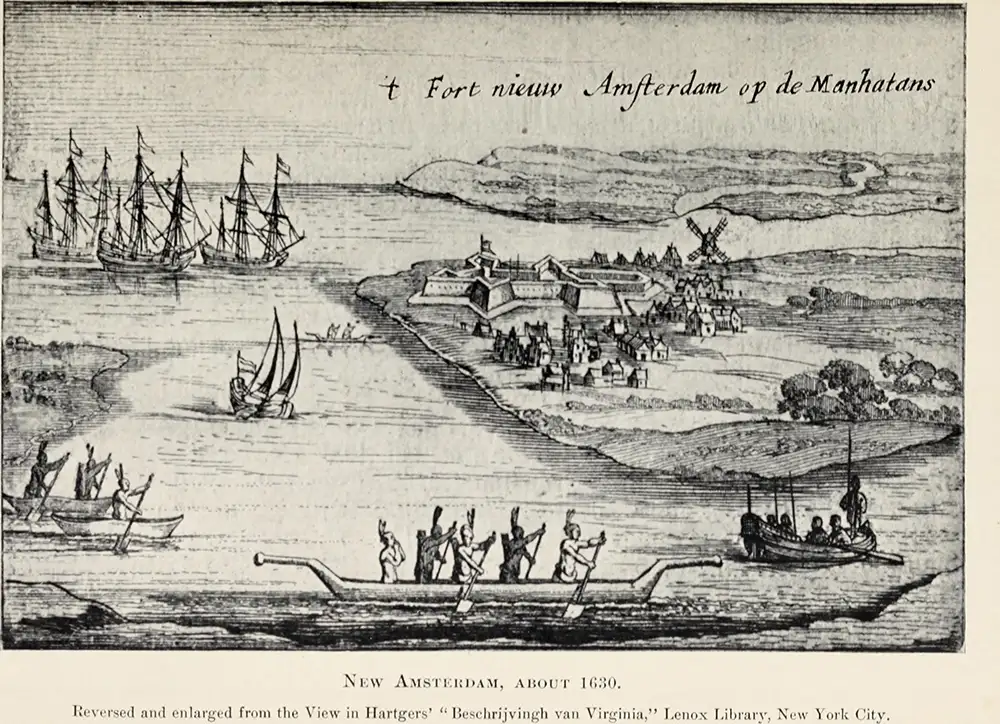
1665 —Towns recognized by the Duke’s Law
The Hempstead Convention was called by the first Governor of New York, Richard Nicoll. Duke's Law promulgated by this convention recognized existing Long Island towns, and also created Ridings (precursors to counties) as judicial districts. A High Sheriff was appointed for the Shire of York, with a Deputy for each Riding also appointed by the Governor. The Ridings helped the colonial governor administer and tax the territory of self-governing towns that were largely inhabited by Puritans and Dutch, neither of whom were likely to be amenable to rule by the Royalist English Duke.
1673 — The Dutch briefly recapture New York/New Netherland
The Eastern Long Island towns of Southold, Southampton, and East Hampton refused to submit and maintained that they were still part of Connecticut.
1674 — The English take back New York
The Eastern Towns continue to assert their intention to remain as part of Connecticut. The Duke of York had a personal enmity for Connecticut because that colony had sheltered three of the 59 commissioners who had signed the death warrant of his father, King Charles the First, during the English Civil War. As a result, the issue of who controlled those towns was forced. New York Governor Sir Edmond Andros threatened to revoke the residents’ rights to the land. The Eastern Towns capitulated by 1676.
1683 — Counties established
The first New York General Assembly adopted a Charter of Liberties and Privileges, which laid out powers and rights of the Governor, legislature, and established rights of freeholders. The General Assembly also dissolved Yorkshire and its Ridings and replaced them with counties. The counties on Long Island were Kings, Queens (which then included what is now Nassau County), and Suffolk. Under the new system, Sheriffs were appointed by the Governor for each county, with no High Sheriff.
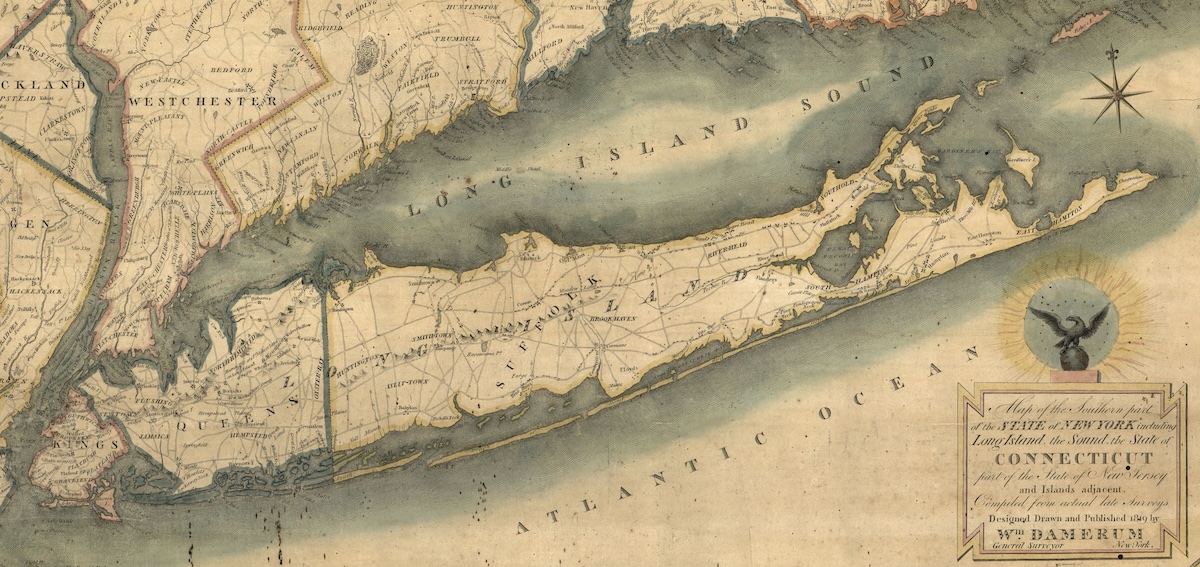
1775 — North Hempstead residents declare independence from Hempstead
Pro-revolutionary residents from the northern part of the Town of Hempstead, disagreed with the Loyalist sentiments of the Town government, who refused to send a delegation to the Provincial Congress in New York City. They signed a declaration that they were no longer a part of the Town.
1777 —New York State’s first constitution
After the Declaration of Independence was signed, the former colony of New York adopted a state constitution. The new constitution recognized the 14 counties that were created in 1683.
1784 — New York State recognizes North Hempstead Township
After the end of the Revolutionary War, the New York State Legislature passed an act to divide the Town of Hempstead, which was signed by George Clinton, the first governor of New York State.
1821 — Sheriffs become elected officials
As a result of a constitutional convention, county sheriffs are no longer appointed by the Governor, but are elected by the voters of their county.
1846 — City and Village incorporation regularized
The New York State Constitution required the legislature to “provide for the organization of cities and villages.” Before that, villages and cities had been incorporated in an ad hoc manner by the State Legislature.
1847 — Village incorporation process established
New York Village Law enacted. The law provides a process for residents to vote to incorporate as a village.
1872 — Town of Babylon formed
Due to rising conflict between residents of the southern half of Huntington Town and the town government, which was located in the northern part of town, a referendum on dividing the town in two was approved in January of 1872. State legislation creating the new town of Babylon was passed in March. Long Island’s current 13 towns have existed since that time.
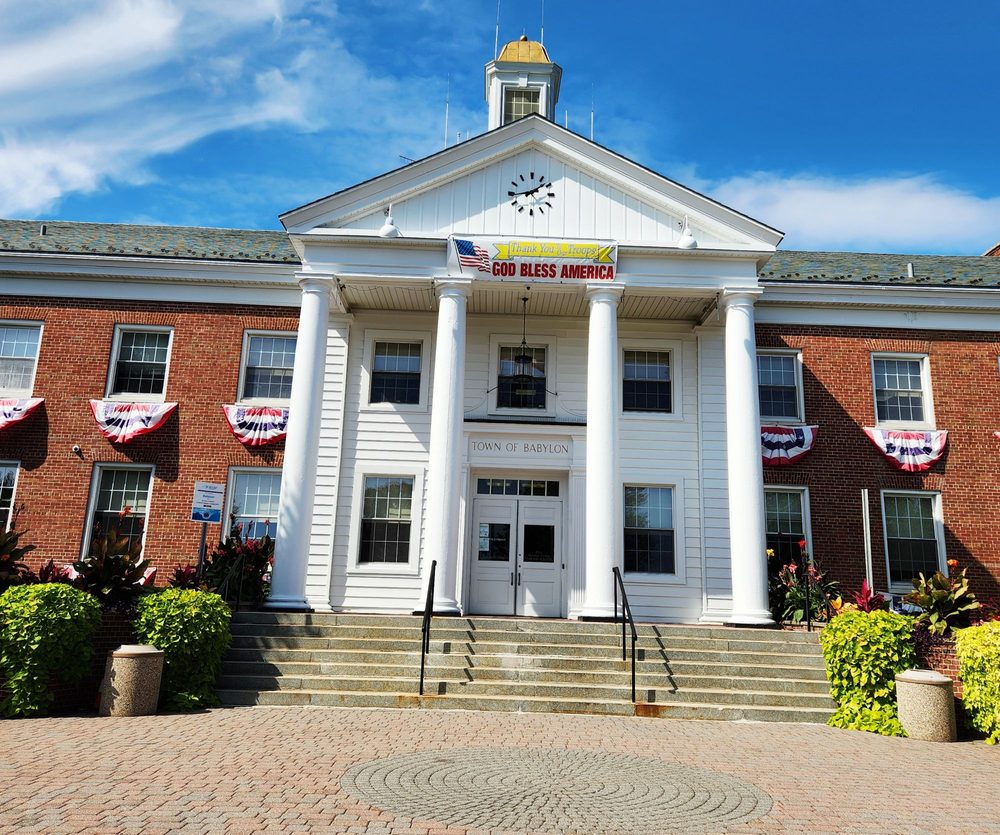
1894 — Home rule
The NY State Constitution of 1894 began the process of establishing ‘home rule’ for cities by placing conditions on the State Legislature’s ability to adopt laws that apply only to specific cities. Through later amendments to the State Constitution, the concept of home rule was strengthened and expanded to all towns and villages. Home rule puts ‘policing power,’ including the power of zoning in the hands of the most local units of government, towns, cities, and villages.
1899 — Nassau County created
In January of 1898, the western parts of Queens County, including the towns of Flushing, Jamaica, and Newtown, Long Island City, and the Village of Rockaway Beach (which was then part of the Town of Hempstead) voted in a referendum to consolidate with New York City and became the Borough of Queens. The rest of the Town of Hempstead, and North Hempstead and Oyster Bay voted against consolidation, and did not become part of NYC, but were still part of Queens County. A group of citizens from these towns pushed for secession from Queens and the New York State Legislature passed a law to create Nassau County, which went into effect on January 1st of 1899.
1917 — City of Glen Cove incorporated
Glen Cove was the first city incorporated in the Nassau/Suffolk region.
1923 — City of Long Beach incorporated
Long Beach became the second of Long Island’s two currently existing cities.
1926 — Long Island Association formed
The LIA is the leading business group on Long Island.
1938 — Nassau County Executive
Nassau was the first county in New York State to create a County Executive to administer the departments of County government. The Board of Supervisors remained as the legislative body.
1947–1970s — Post-WWII population growth
As a result of the rapid suburban development of Nassau and Suffolk counties from the late 40s through the 70s, Long Island has become home to "mega-towns." The Town of Hempstead is the most populous town in the United States. It has a higher population than four U.S. states. The four most populous towns on Long Island (Hempstead, Brookhaven, Islip, and Oyster Bay) have populations greater than the City of Buffalo, making them the largest municipalities in NY State outside of New York City. Three more Long Island towns have populations over 100,000 (Babylon, Huntington, and Smithtown).
1968 — Nassau County Sheriff becomes an appointed position
A referendum passed by Nassau voters in 1965 changed the office of Sheriff from an elected position to one appointed by the County Executive and approved by the Board of Supervisors. The law went into effect in 1968. The New York State Constitution states that "the sheriff and the clerk of each county shall be chosen by the electors." It grants exceptions only for the five counties in New York City. Although Nassau has no exemption from the constitutional requirement for an elected sheriff, the appointment of Nassau's sheriff has never been challenged in court.
1970 — Suffolk County Legislature
The Board of Supervisors system was challenged in federal court on the basis that it violated the one-person, one-vote principle. In 1968, the court ordered Suffolk County's government to reapportion to provide equal representation based on population. A referendum on the new form of government was approved by voters that same year. Elections for the new legislative seats and County Executive were held in 1969, and the first session of the Legislature was held in 1970.
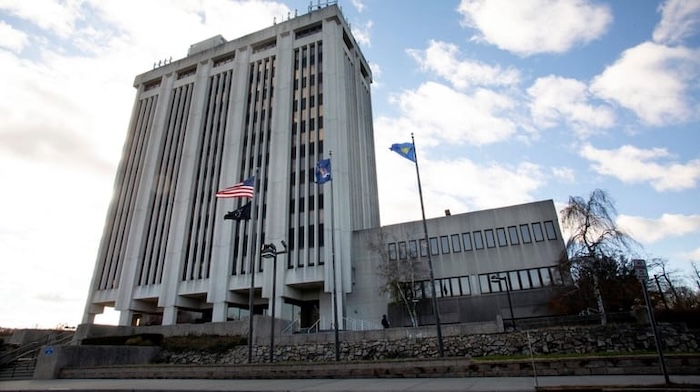
More Details +
Since colonial times, Suffolk County had been governed by a Board of Supervisors, a body made up of the supervisors of Suffolk's 10 towns. Each supervisor had one vote on the board, regardless of the population of the town. This system was challenged in federal court on the basis that it violated the one-person, one-vote principle. In 1968, the court ordered Suffolk's government to reapportion to provide equal representation based on population. A referendum on an 18-member legislature representing equal population districts was approved by voters that same year. Elections for the new legislative seats and County Executive were held in 1969, and the first session of the Legislature was held in 1970. The term of office for Suffolk County Legislators is two years, and for the County Executive, four years.

1993 — Suffolk County adopts term limits
The 1990s saw increasing calls for term limits on elective office. In 1993, Suffolk County was the first county in New York State to adopt term limits for county elected officials. Legislators, the county executive, and the county comptroller were all limited to 12 consecutive years in office. In 2022, that was changed by referendum to a lifetime limit of 12 years, whether consecutive or not. Although most towns on Long Island have no term limits, the towns of Brookhaven, Huntington, and Riverhead have limits of three consecutive terms, or 12 years for Supervisor and Town Council Members. Islip has a limit of three terms, whether consecutive or not. Southampton has an 8-year total limit on serving as Supervisor or Town Council Member.
Patch.com article about the referendum to adopt term limits in Suffolk.
1996 — Nassau County Legislature
In 1993, a federal court determined that Nassau County's Board of Supervisors was unconstitutional because it failed to comply with the principle of one person, one vote. Under a weighted voting system, the Hempstead Town Supervisors effectively controlled the entire county government. The Nassau County Commission on Government Revision recommended a legislative system with 19 districts along with several other reforms. In November 1994, the voters approved the charter revision in a referendum. The first elections in each of the 19 new legislative districts, were held in 1995, and the new Nassau County legislature held its first session on January 1, 1996.
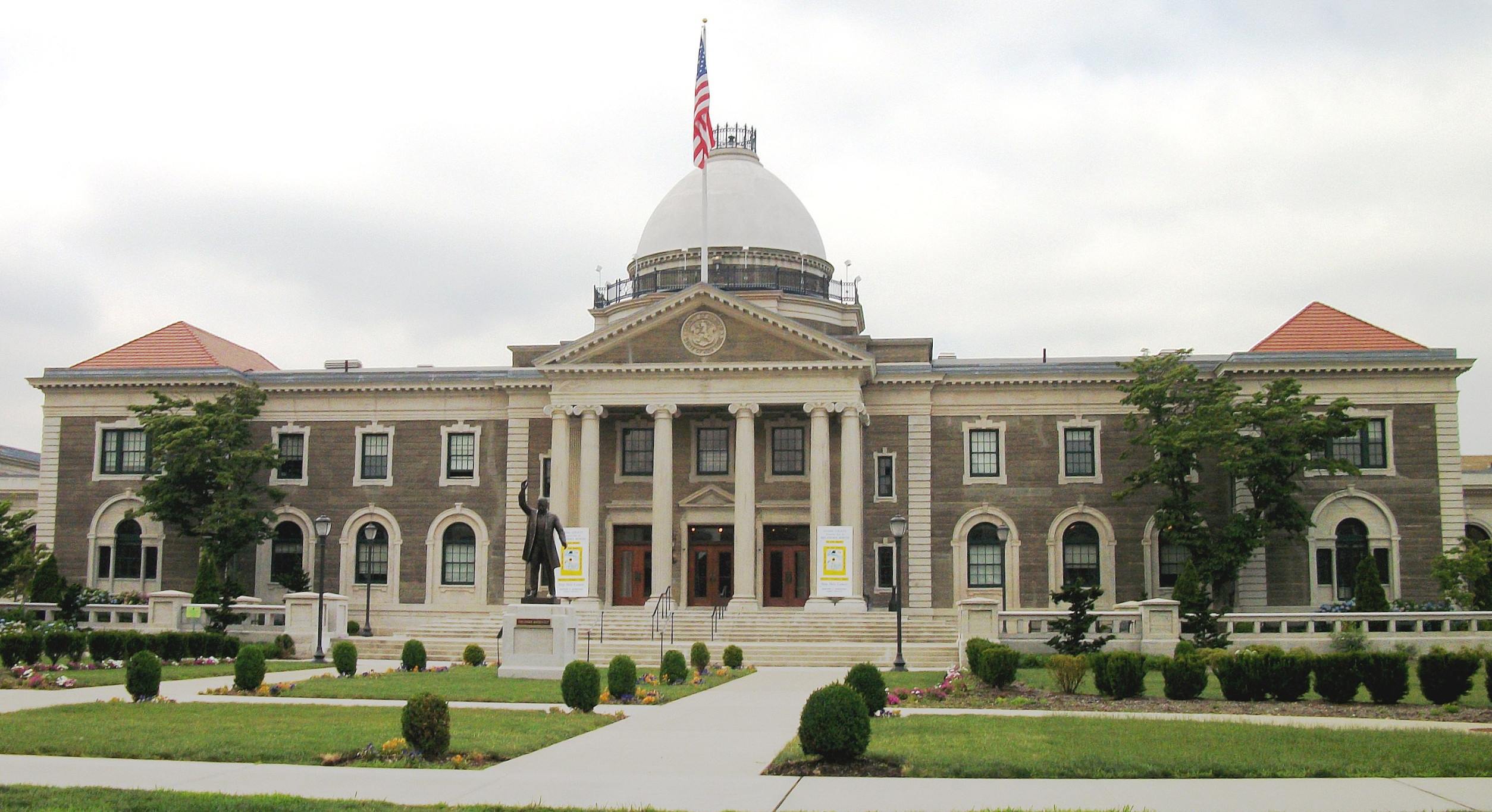
The old Nassau County Courthouse, now called the "Theodore Roosevelt Executive and Legislative Building." Photo by DanTD CC BY-SA 3.0
Nassau County government's history webpage.
More Details +
In 1993, a federal court determined that Nassau County's Board of Supervisors was unconstitutional because it failed to comply with the principle of one person, one vote. Until then, the town supervisors had an extra responsibility in running county government, and because the town of Hempstead (America’s largest town) has more than half of Nassau’s total population, under a weighted voting systems, the town supervisors from Hempstead effectively controlled the entire county government. Federal Judge Arthur Spatt described the weighting system as "a mathematical quagmire,” and ruled it unconstitutional.
In March 1994, the 17-member Nassau County Commission on Government Revision, Chaired by John B. Kieran, completed its work and recommended a legislative system with 19 districts along with several reforms. Consistent with the Voter Rights Act, minority voters constituted a majority of the voters in two of the districts. The reforms included: a bi-partisan budget review office, a new office of minority affairs, a line-item veto over the budget for the county executive, an ethics board, a requirement to post a 5-year capital improvement plan, and expansion of the Nassau County Planning Commission from 5, to 9 members. The commissioners, who are appointed by the County Executive and confirmed by the Legislature for 3-year terms, must each be county residents, including at least one from each of the County’s three towns, four who are village residents, one with a business background, one with environment conservation background, and one active in advocating interests of minority residents or community development or public housing. The Planning Commission was also directed to complete a county-wide master plan.
In November 1994, the voters approved the charter revision in a referendum. The first elections in each of the 19 new legislative districts, were held in 1995, and the new Nassau County legislature held its first session on January 1, 1996.

The old Nassau County Courthouse, now called the "Theodore Roosevelt Executive and Legislative Building." Photo by DanTD CC BY-SA 3.0
Nassau County government's history webpage.
2002 — Brookhaven voters approve district-based elections
Previously, all towns on Long Island elected Town Council Members through town-wide, at-large elections, with slates of candidates competing for a pool of open seats. Brookhaven voters approved a referendum to switch to electing Council Members from specific districts, with head-to-head elections, similar to elections for County Legislators, State Assembly Members, State Senators, and U.S. Representatives. Since then, three more Long Island towns have adopted the district system.
More Details +
Previously, all towns on Long Island elected Town Council members through town-wide, at-large elections, with slates of candidates competing for a pool of open seats. Brookhaven voters approved a referendum to switch to electing Council members from specific districts, with head-to-head elections, similar to elections for County Legislators, State Assembly Members, State Senators, and U.S. Representatives. Since then, three more Long Island towns have adopted the district system: North Hempstead through a referendum; and Hempstead and Islip as a result of court decisions that found the at-large system suppressed minority representation. All other Long Island towns and cities still elect Council members at-large.
More about Long Island town and city councils:
Most towns on Long Island have four Council Members. The towns of Brookhaven, Hempstead, North Hempstead, Oyster Bay, and Southold each have six. Town Supervisors vote on the Town Board, ensuring an odd number of votes to prevent ties. The City of Glen Cove has six City Council Members and a voting Mayor. The City of Long Beach has five City Council Members and a non-voting, appointed City Manager.
2011 — Property tax cap
New York State passes a property tax increase cap law. It is called the 2% cap, but actually limits local municipal, special district, and school budget tax increases to 2% or the rate of inflation, whichever is lower. School district budgets that exceed the cap must be approved by a vote 60% or greater, while those that stay under the cap can be approved with a bare majority of over 50%. Analysis by the Rockefeller Institute of Government found that average annual school tax increases on Long Island fell from 3.5% before cap was enacted to 1.9% in the years following, and the percentage of districts exceeding the cap was in the single digits. They estimate Statewide property tax savings of $25.6 billion from 2012 through 2018.
2011 — Regional Economic Development Councils
NY State establishes Regional Economic Development Councils (REDC) to identify projects of regional importance for economic development, to receive competitive grants. Since 2011, the first year of the initiative, NYS Regional Economic Councils over $7.5 billion has been awarded to more than 9,200 projects.
2017 — Village of Mastic Beach dissolved
In November 2016, residents voted to dissolve the Village of Mastic Beach, which had been incorporated in 2010. A Final Dissolution Plan was adopted by the Board of Trustees in March of 2017. This leaves Long Island with 95 villages. Three other villages have been dissolved in Suffolk County history: two in the 1930s and one in 1990. No Nassau County village has ever been dissolved.
Long Island Press article about the dissolution of the Village of Mastic Beach.
More Details +
In November 2016, residents voted to dissolve the Village of Mastic Beach, which had been incorporated in 2010. A Final Dissolution Plan was adopted by the Board of Trustees in March of 2017. This leaves Long Island with 95 villages. Three other villages have been dissolved in Suffolk County history: two in the 1930s and one in 1990. No Nassau County village has ever been dissolved.
Long Island Press article about the dissolution of the Village of Mastic Beach.
The three most populous villages and the three least populous villages in New York State are all found on Long Island. The Village of Hempstead has a population of 59,169, greater than the cities of Troy, Binghamton, or Niagara Falls. The population of the Village of Freeport is 44,472 and of the Village of Valley Stream, 40,634.
The three lowest-population villages in New York are West Hampton Dunes–126, Saltaire–113, and Dering Harbor–50.
2019 — Property tax cap made permanent
The property tax cap law was made permanent by the State Legislature.
Summary and Analysis
The legacy of colonial and early New York State history has left Long Island with what can be characterized as a complexly layered and balkanized system of local government. However, the principle of home rule is intended to keep the decisions that most affect people’s day-to-day lives at a governmental level closest to them, where individual citizens have the greatest influence. This patchwork of jurisdictions can complicate regional planning and service delivery, but it also provides opportunities for meaningful civic engagement. In today’s policy environment, where efficiency, equity, and coordination are in demand, understanding the origins and functions of our local institutions is key to making democratic reforms that preserve community control while improving governance outcomes.